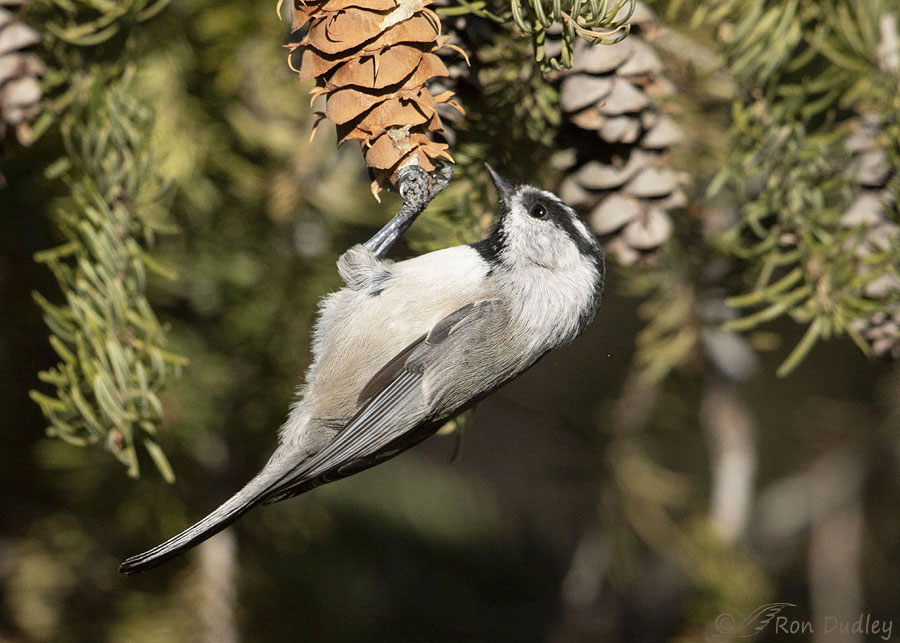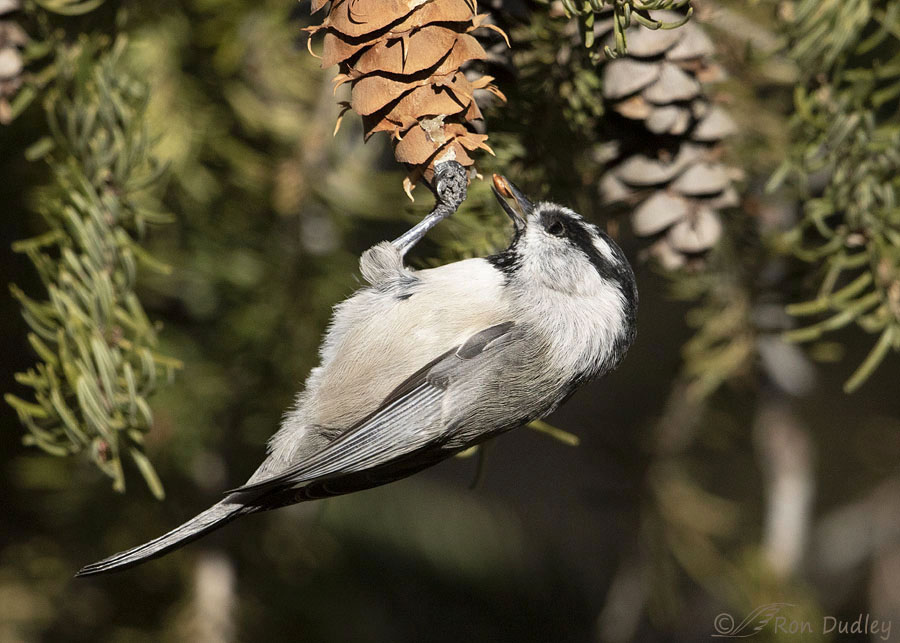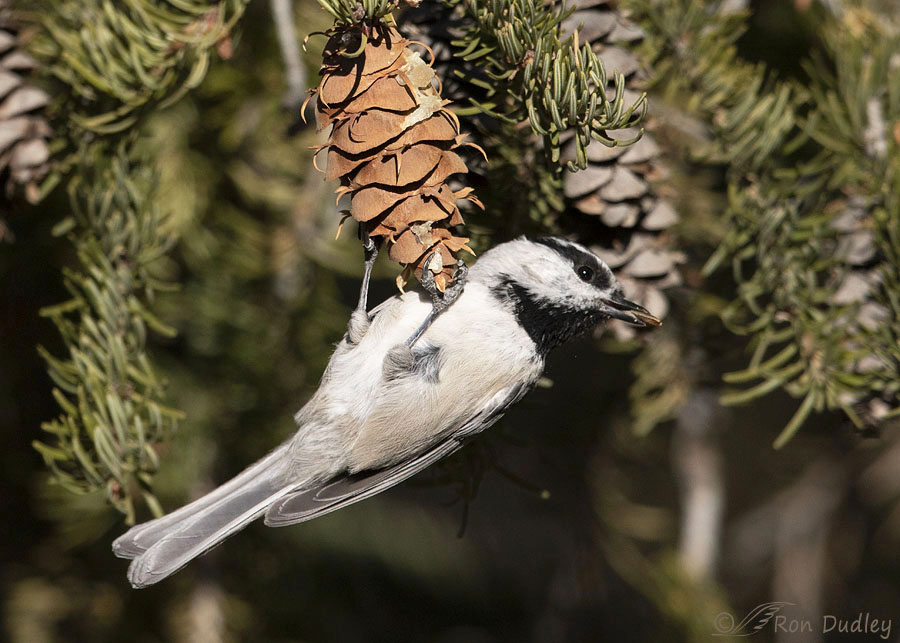A quick, furtive process that’s difficult to photograph well.

1/6400, f/6.3, ISO 800, Canon 7D Mark II, Canon EF 500mm f/4L IS II USM + EF 1.4 III Extender, not baited, set up or called in
Early last winter I spent some time with nuthatches and chickadees as they were feeding on Douglas Fir seeds in the Stansbury Mountains. This Mountain Chickadee is just about to extract a seed from between the cone scales at the bottom of the cone.
I didn’t save any of the photos (if I got any) of the chickadee actually tugging on the seed, probably because its face was hidden from view during the process but…

1/6400, f/6.3, ISO 800, Canon 7D Mark II, Canon EF 500mm f/4L IS II USM + EF 1.4 III Extender, not baited, set up or called in
this photo was taken immediately after the seed was extracted. There’s no light in the eye but I think the seed in the bill makes up for it.
Once they have the seed in their bill they don’t stay on the cone for long.

1/5000, f/6.3, ISO 800, Canon 7D Mark II, Canon EF 500mm f/4L IS II USM + EF 1.4 III Extender, not baited, set up or called in
They look around for a very brief moment to plan their escape route between all the branches and cones and then they take off with the seed. If I’m lucky I can see them caching their prize in some ‘secret’ location but usually it’s in a secluded spot in the shade where the caching process can’t be photographed well.
This time I missed both the takeoff and the caching shots but I’m pleased to have photographed the chickadee on the cone with the seed.
Ron
Note: When I’ve posted photos of Mountain Chickadees in the past there always seems to be a few folks who confuse them with Black-capped Chickadees. Note the white superciliary stripe above the eye on this Mountain Chickadee that Black-capped Chickadees don’t have..


Superseries Ron!
Charlotte Norton
I’m always amazed, but not surprised, that you can get photos like these.
We have lots of Black-capped Chickadees here and tons of Douglas-firs, so I’m sure I don’t need to be feeding them; but of course I do anyway for the entertainment. Surprisingly, I’ve seen them take off with nuts and large as cashews and walnuts halves. Pigadees.
“Pigadees”, I’m gonna remember that one, Lyle. Might even give you credit when I use it….
“nuts and large as cashews and walnuts halves.” Why do I always catch my typos when they are posted? Embarrasing.
Thank you for some delightful photographs of a lovely bird hard at work. The clear, crisp images are in contrast to the hazy, smoky skies I faced this morning.
Yep, we’re on fire again — a couple are within 20 miles of us. I have the house closed up, but the smoke is seeping in. Hopefully, the winds will die down as the day goes on and the firefighters, wildlife, and closer residents will get some relief.
I was just reading about those fires, Marty. When wall they ever end!
Very nice photos! Chickadees have Velcro toes. When rehabbing them they will jump on your hand when you reach into the cage to add food. They are impossible to shake off!
I have a lot in my yard this year . They are noisier than black-capped chickadees.
How I would love velcro toes – which would probably have saved me more than once from the kaboom, splat scenario.
I need them too, I had the hardest time while in Australia, I tripped and fell often, every time there was a change in pavement there would be a one or two inch rise that I would catch my toe on and go down. One of the houses we rented had three of these in the house, two in doorways and one where the kitchen floor met the living room floor. I became the brunt of the jokes. I was traveling with 2 occupational therapists and 3 physical therapists.
I could also benefit from velcro in various and sundry places!
“Velcro toes”. I love it, April.
Yet ANOTHER beautiful, industrious, acrobatic charmer which you have captured and given to us.
Many thanks. My usual dose of awe and wonder (and delight) are a most excellent start to the day.
Thank you, EC.
The cone of a Douglas Fir has some fun folklore stories…it looks like it has a mouse caught up in the cone, with the tail and two back feet sticking out. Fun to share w/kids
Fun to share w/kids

My shortened version is: D.Fir gave mice permission to eat their seeds to survive during a drought…then when good rain years came, making food abundant/the mice still kept going up the d.f. at night to eat their seeds. When asked not to do that anymore, as they were needed to grow more d.firs, the mice just “dissed ” them…so one night, ALL the D. Firs decided to clamp down on the mice…still evidence of them trapped in cone
Great capture of the chickadee
I really love that – thank you. It is just the sort of story my father would havve loved to tell.
Cute story, Carolyn. I can see why kids especially would love it.
Wonderful capture, Ron…… The seed in beak more than makes up for the missing catch light. Even the Black Caps can be hard to capture as they flit about with their “prize”. The exception is when they’ve gotten a hulled sunflower seed and are trying to pound it open on a branch or whatever.
The seed in beak more than makes up for the missing catch light. Even the Black Caps can be hard to capture as they flit about with their “prize”. The exception is when they’ve gotten a hulled sunflower seed and are trying to pound it open on a branch or whatever.
Judy, when it comes to difficulties for the photographer I think both chickadee species present similar problems. Their middle name is “grab-the-seed-and-run”.
Interesting post Ron and good photos. Would be neat to see where the caching usually takes place, but as you say it must normally be in secretive locations where it is hard to photograph. Guess the easiest to see caching is done by the Acorn Woodpeckers whose granary trees are there for everyone to see.
Everett, they often seem to cache their seeds in chinks in the bark, often at or near the junction between a branch and a larger branch. Sometimes in the same tree and sometimes in a different tree.
Chickadees are delightful acrobats and quick as a whip. This little guy is no exception. Wonderful photos, Ron. With the light in the bird’s eye in 2 out of 3 of these photos I am sure there is a twinkle in yours!
My eyes are twinkling away, Melanie. It’s quite difficult to get light in the eye of these birds on the cones because they’re usually looking at the cone they’re on and often have their backs to me.
What an appealing bird, and an excellent photo. I’m not sure I’ve ever seen cones with seeds still in them (I’m short on pines, and honestly haven’t looked), but the birds certainly know where they are.
Thanks, Shoreacres. When seeds are still in the cones they’re mostly hidden, especially before the cone scales open.